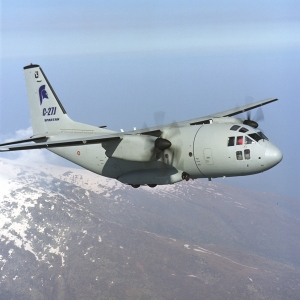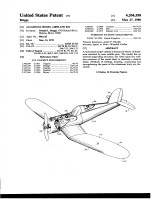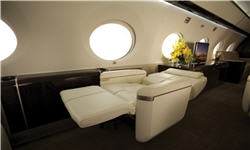
Online Article: From the Magazine—
by Budd Davisson

It was in the cavernous back pit of a T-28A that I first came to know the meaning of the word "Humungous." Those first few hours were primarily hide and seek affairs with me doodling with my cameras and making believe I knew what I was doing. But, ever so often we'd hit some lousy photo weather and I'd revert to my basic role . . . frustrated fighter jockey. It was during those times, with my legs spread ridiculously wide to the galosh-sized rudder pedals and my hand sitting on top of a ball bat control column, that I first got to know the T-28A. Bear in mind that I looked like a lumpy Teddy Bear, trussed into a flight suit with lenses, cameras and film stuffed in every conceivable nook and cranny the suit had to offer.
You couldn't have stuffed me into a normal sized cockpit with a size-14 shoe horn. Still, as I sat there, jockeying the T-28A around, I was curiously aware of the fact that I was hardly occupying any space at all in the back pit. You could have gotten two more of me in there and still had room for a girl or two (well, it's never too tight).

During that first introduction I was able to take over the controls and pull hard to begin a big barrel roll, to try and fall in behind Max Hoffman, who had been flying wing in his P-40E Warhawk. Max knew what I had in mind and rolled into me before I got into firing position. Then, he being a gentlemen and keeping his power down to 25 or 30 inches, the fight was on. I was loving it!

The first time I had ever laid my hand on the controls of a T-28 and I found myself upside down with a P-40 painted on the windscreen as we rolled in trail. The T-28 was the perfect airplane for this kind of skylarking. Its barn door snout keeps it from picking up speed like a crowbar going downhill and its big wing lets it turn inside a racing pigeon. So, whatever the P-40 did, I just hung on to his tail. I knew Max wasn't about to hit the ground so all I had to do was follow the hole he was punching through the air. However, as much fun as we were having, I really didn't learn anything about the T-28A that first trip, except how to make myself a little green around the gills.
Shortly there after, I got my chance to go at the T-28A in a more formal fashion, with a regular cockpit familiarization and full checkout. This T-28 wasn't your usual A-model . It's sort of a hybrid, or bastard, if you will. It still has the original R-1300 Wright engine (800 hp) but equipped with a 3-bladed prop to try and increase some of his performance numbers, some of which are supposedly pretty marginal on an A Model.
If you sit down and look at a T-28A closely it looks like they've reversed the old fighter design axiom of ". . . biggest motor with, littlest airframe . . ." Here it looks like they took the littlest current production motor they could find (R-1340s were out of production) and hung the biggest possible airframe they could design and still put two people in it without looking ridiculous. Some folks say it looks ridiculous anyway. God knows, it sounds ridiculous. Single row radials all have a less than ferocious sound, something like "Chickenpluckin, chickenpluckin, chickenpluckin." Say it fast and you sound like a T-28A going up hill. Anyway, with such a large aircraft, 800 horses have to puff awfully hard to take it anywhere in a hurry.
Of course, the Navy's Bravo and Charlie model T-28s solved all that by hanging an R-1820 upfront. With 1424 hp, the T-28 had no choice but to haul ass in just about every facet of flight. Then, to capitalize on this near-fighter performance, some older airframes were modified to "D" model specs, which included hardpoints for rockets and gun pods and bill of sales made out to countries with funny sounding names.

As I first walked up to Enhorning's A model, the first thought that went through my mind was "Jesus, I hope I don't slip off the wing. I'd bust my tusche into a dozen pieces," because the T-28A's wing is exactly head high to the average pilot. The cockpit rails are probably 15 feet off the ground and require a fairly healthy trek up the spring loaded steps in the flap and across the wing.
I had glanced through the handbook for the airplane earlier so, as I was screwing around with the parachute and seat belt straps, I glanced around to see that everything was where the book said it would be. It was. North American doesn't appear to have changed very much in any of their propeller driven airplanes since before World War Two. You can almost always count on the flap handle being on the rear of a console under your left arm. The rudder, aileron and elevator trip are located just in front of the flaps on the top of the console with the throttle, mixture and prop quadrant directly above them. The one break from T-6/Mustang tradition was putting the gear handle up on the left side of the panel instead of down near the floor by your left foot where it was a pain to reach.
Starting the 28 required a bit of orchestration with the fingers of my right hand to get everything going at once. Turning the fuel on automatically fires up the boost pump and feeds from all four tanks at once, there is no selector. Then, kicking on the battery starts things buzzing. The book says to prime the engine for ". . . 1/2 to one second ... !" but Enhorning let me go for nearly two seconds on the button actuated primer. Then I engaged the starter, counting the blades as they came by. When I had three blades, I reached up with a spare finger and threw both mags on, no small trick since the starter and mags are not conveniently located next to each other. A few more mini-shots of prime and I got that exciting hollow sounding cough that says the engine has just swallowed a little residual oil and is about to do its number. As the coughs got closer together, I reached up with my left hand and slammed the mixture into full rich and we had a purring 800-horse pussy cat on our hands.

Since it was cold as hell out so I pushed the canopy handle into the detent marked "closed." Once it was seated, I pushed the button on the top and a hydraulic cylinder squeezed the canopy closed as slick as glass. This was one of the last A models built and has the so-called low profile canopy so I ducked a little as the plexiglass began to envelope me. No need to duck, since the glass was at least eight inches over my head.
With everything strapped, buttoned, fastened and nailed down, I brought the power up and depressed the lever on the front of the stick with my little finger to engage the nosewheel steering. With the lever down the airplane steers with the rudders. Without it you have to use the brakes to keep from flattening Cessnas, fuel trucks and small hangars. Of course, there is no reason to ever hit anything because you have such a fantastic field of view. I felt like Jungle Boy on the neck of his favorite elephant looking around at the natives scurrying away from this snorting monster that threatened to scarf-up Cherokees without even belching.
The only thing of any great significance prior to the takeoff was the run up. You cycle the prop at 1700 rpm, but go for the mags at 2100 rpm, and, unless you've stood there with, your entire weight on the brakes as you crank 800 horses up to 2100 rpm, you can't appreciate what that means. That was when I came to full realization that this was no tinker toy I was about to launch in. Tinker toys don't ruin 2 acres of corn at the end of the runway with their prop blast during runup. T-28s do.

The wind was blowing like the hammers of hell directly across the runway, so I double checked the required 7 degrees of right rudder trim and made up my mind to leave the nose wheel down a little longer than usual to give a clean rotation. Okay kid, no way to back out now, and I riveted my attention on the centerline and gently began to feed the lion some meat. Funny, but when you bring the power up and are rocketing down the runway, it doesn't sound like it's going "chickenpluckin" at all. As a matter of fact, as I bounced around the cockpit, doing my best to monitor, manifold pressure (keeping it at 45 inches), airspeed (I wanted to rotate at 85-90 knots) and runway (I didn't want to go trolloping into the bushes), I felt like I was flying an honest-to-goodness fighter. Okay, so maybe I could see over the nose and the torque was almost unnoticeable but the feeling was there, even if the performance wasn't.
As the needle stabbed at 90 knots I tweaked back on the stick and the T-28A hopped off the ground and totally ignored the wind as it trucked straight ahead. I grabbed the giant gear handle and tried to pull it up and found I had to give it a couple healthy tugs to make the wheel symbols disappear in the little windows on the panel. Then I set up climb power of 34 inches and 2300 rpm, which gave about 1800 fpm on the VSI at about 110 knots. Not much compared to the 4,000 fpm a "C" model is capable of, but we were doing it at about half the fuel consumption.
As we climbed up to 7,000 feet to do some playing, I diddled with the trim and found you could almost dial the airplane in the direction you wanted to go. The machine is extremely stable on all axis, so you could trim it into a climb, bank or whatever and it would stay there as long as you wanted it too.
Once at altitude in our local practice area, I performed the ritualistic clearing-dance; a couple of very tight, high-G 90 degree turns, followed with a maneuver us Okies use to make New Jersey look good . . . we put it upside down and then twist it into brown and blue pretzels, wiping it around the top of the canopy as many times as our airspeed will let us. Other folks call them aileron rolls, we call them whatever comes to mind at the time.
In all aerobatics the T-28A is excellent, if maybe a little heavy handed in the aileron department. The roll rate is a little on the sedate side and for the first time that I can remember, I found an airplane with a decided amount of roll inertia. Once you get it going you have to lead your point of roll-out a little or you'll overshoot. Just releasing the ailerons won't stop it.

The ailerons aren't very well harmonized to the elevators, which are reasonably light, or the rudder, which is just about right. We did four and eight point rolls (which are real fun with the roll inertia), Cuban eights, and Immelmans and found it literally "grooved" through maneuvers . . . you just set it up and it would do the rest.
With it all cleaned up, the stalls are really surprising . . . there almost aren't any. It will wallow down to around 68 knots, buffet like a subway car, and then mush forward, straight forward, with the stick held all the way back. I was amazed! Even a T-6 bites much harder than that. With the gear and flaps out, it's a different story. The buffet is much, less pronounced and the stall breaks cleanly with a sharp roll to the left. It doesn't suddenly leap for the ground while rolling over on its back like a Mustang or Bearcat, but it's no Cherokee.
I tried to time some rates of descent power-off, but couldn't because with anything less than about 20 inches of manifold pressure, the cylinder head temps fall right out of sight. The best I could approximate was about 3,000 fpm down with 140 mph (gear speed) and 20 inches, which is hardly a good indication of anything.

In cruise we were showing a solid 180 knots at 6,000 which at our OAT was almost identical with the TAS. Enhorning says he flight plans 175 knots (201 mph) and is almost never very far off, which means a dent in his gas budget of about 43 gallons per hour, not exactly the kind of figures which make environmentalists happy.
Coming back into the pattern I elected to make a normal 180 degree rectangular pattern since a 200 knot, 360 overhead would throw the local faddy-daddy flight instructors into a tizzy. As I was on the 45-degree leg onto downwind I still had a solid 170 knots indicated and the bird showed no signs of slowing down. Since I didn't have the speed brakes of the B & C models, I delayed the turn onto downwind a bit and racked it into a relatively tight bank letting the G burn the speed down to the 140 knots I needed to throw the gear and half flaps out. Enhorning said he uses 90 knots over the fence, so I nailed the airspeed on 100 knots as I cleaned up the cockpit, returning mixture to full rich (we had been flying on auto-lean), prop up to 2400 rpm, double and triple checking the gear and saying four Hail Marys.
The wind had, as is usually the case on a first flight, gotten much worse and I expected to have my hands full on final. But, as I jockeyed the power a little to maintaining a good glide slope and pulled the nose around straight with rudder, leaning into the wind with the aileron, I could see it takes more than 20 to 30 knots to worry a hoss the size of a T-28A. I was almost hypnotized by the point I had picked to touchdown on and was playing with it in the windshield, keeping it totally stationary with power. Then, as my point was eaten by the nose, I bled the power off and gently flaired, feeling for the ground with these ridiculously long gear legs. A couple of "clanks" and one wiggle and that was it. I let the airplane roll the full length of Sussex's 3,500 foot runway, so as to not wear out the brakes.
Running the engine up to 1200 rpm for about a minute to scavenge oil out of the case, I brought the mixture into idle cutoff position and opened the magic canopy at the same time. As the cold air and the clanking sound of the big radial unwinding flowed in and settled around me, I felt like I had had a real experience. The emotion was little different than what I had felt when climbing out of a Mustang or a Bearcat for the first time. The smells, the feel, the hardware, everything about the T-28A is military and fun, and that is what makes the T-28A owners smile so much.
Back in the late ‘70s Bravo and Charlie models in civvies were rare and ran as high as $50,000 or more. (Editor’s Note: Ah, the good old days!) Today however, there’s no telling what prices you’ll find. Depending on the condition of the airframe and engine, you can expect to pay anywhere from $195,000 to close to 500K. With the price of gas being what it is, and will be, it's difficult to rationalize springing for a bird that slurps up fuel at around 60 gallons an hour. Also, almost all of the Navy birds are going to be very, very tired of flapping their wings and many are going to be way past due for retirement.

But, they won't retire. As long as there are old soldiers, old movies and old airplanes, there will be good old boys who want to play war. For those who have neither the talent nor the bucks to do it in a for-real fighter, the T-28A is the way to go. And it's a good way to go. If you don't believe that, ask the guy who parks his next to a Mustang. P-40 and Bearcat. Ask George and see what he says. All he'll do is smile and nod his head.
View the original article here








 9:50 AM
9:50 AM
 naim
naim

 Posted in
Posted in

 Check BUILT photos below!
Check BUILT photos below!



 Online Article: From the Magazine—
Online Article: From the Magazine—








 Model of Phenom 300 (2006 photo)
Model of Phenom 300 (2006 photo)
 Aluminum model airplane kit (www.patentstorm.us)
Aluminum model airplane kit (www.patentstorm.us)
 Albatros c. III
Albatros c. III




